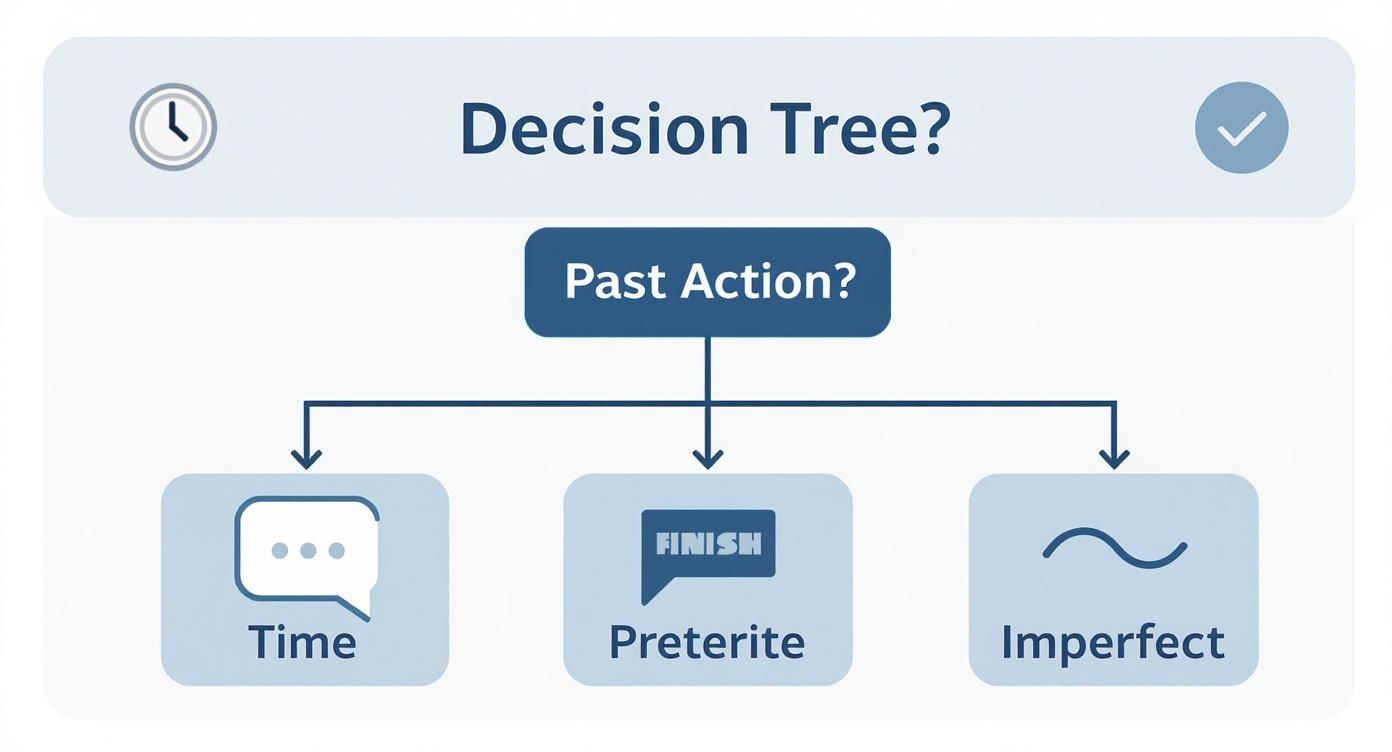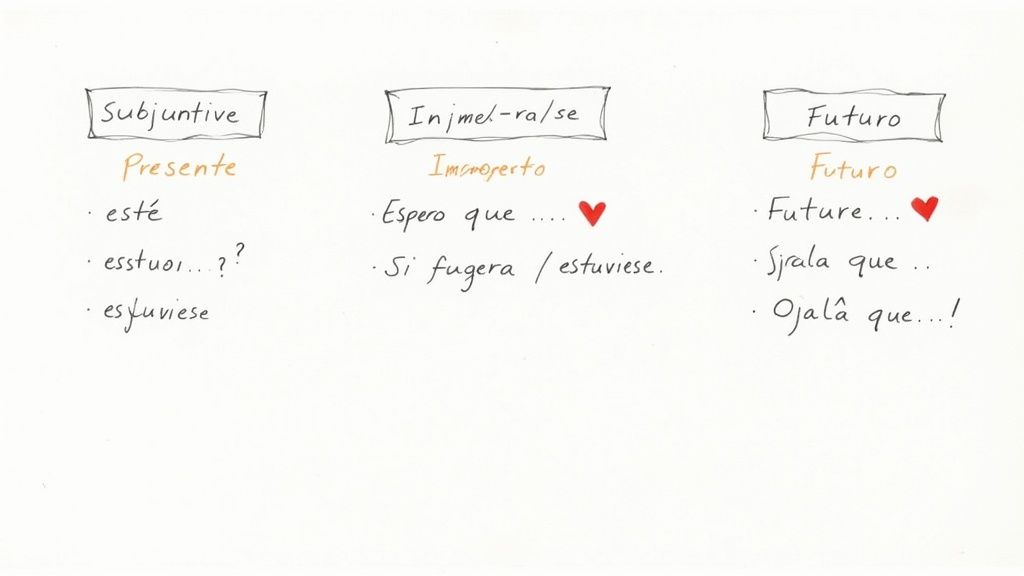Your Ultimate Guide to the Conjugation of Estar
Looking for the right conjugation of estar in a hurry? This quick reference chart is your go-to for the most common forms you'll run into in everyday Spanish. It gives you a simple, direct way to look up the essential tenses without getting bogged down in too much detail.
Estar Conjugation Quick Lookup (Indicative)
To help with quick recall, the table below lays out the most frequently used indicative tenses for estar. These three forms—present, preterite, and imperfect—are the absolute backbone for talking about locations, temporary states, and actions that were ongoing in the past.
Getting these down is a huge step forward, and honestly, many learners find that mastering the basics helps them see that learning Spanish is easier than they expect.
| Pronoun | Present (I am) | Preterite (I was) | Imperfect (I was/used to be) |
|---|---|---|---|
| yo | estoy | estuve | estaba |
| tú | estás | estuviste | estabas |
| él/ella/usted | está | estuvo | estaba |
| nosotros/as | estamos | estuvimos | estábamos |
| vosotros/as | estáis | estuvisteis | estabais |
| ellos/ellas/ustedes | están | estuvieron | estaban |
Think of this chart as a handy tool to double-check a conjugation just before you speak or write. It’s perfect for building confidence while you dive into the more detailed explanations of mood and usage we cover later in this guide.
Mastering When to Use Estar Instead of Ser
One of the biggest hurdles for anyone learning Spanish is getting the hang of ser versus estar. They both translate to "to be," but you absolutely can't swap them out. Using the wrong one can completely change what you're trying to say.
The fundamental difference really boils down to permanence versus a temporary state. Think of ser as defining what something is—its core, unchanging qualities. On the other hand, estar describes how or where something is right now. Getting this distinction right is a massive step forward in your Spanish journey.
The Core Functions of Estar
The main reasons you'll reach for a conjugation of estar fall into a few clear-cut categories, all circling back to that idea of a temporary condition. You should always be using estar for:
- Location: This is a big one. Estar is your go-to for describing where a person or object is physically located, even if that location feels permanent.
- La biblioteca está en el centro. (The library is in the centre.)
- Nosotros estábamos en Singapur. (We were in Singapore.)
- Temporary Conditions and Emotions: Use estar to talk about feelings, moods, and physical states that are subject to change.
- Hoy estoy muy cansado. (Today I am very tired.)
- Ella estuvo enferma la semana pasada. (She was sick last week.)
- Progressive Tenses: To talk about an action in progress, you'll pair estar with a gerund (the -ando/-iendo form of a verb).
- El niño está leyendo un libro. (The boy is reading a book.)
To help you visualise which tense to pick, this decision tree maps out how to select the right form of estar depending on the timing and context.
As you can see, actions happening now call for the present tense. For past actions, you'll need to decide between the preterite (for completed events) and the imperfect (for ongoing descriptions).
A handy little rhyme many learners use is: "For how you feel and where you are, always use the verb estar." It’s a simple but effective way to remember its two most crucial functions—location and condition.
Once you really internalise these rules, you'll find yourself moving beyond direct translation and starting to think more like a native speaker. The choice between ser and estar will begin to feel instinctive as you focus on whether you're describing a temporary state, a location, or an action in progress. It’s a genuine milestone on the path to fluency.
A Guide to Estar in the Indicative Mood
When you’re talking about facts, describing what you see, or sharing information you believe is true, you’re using the indicative mood. Think of it as the default, most-used mode in Spanish. So, if you want to get a real handle on the conjugation of estar, the indicative tenses are where you need to build a rock-solid foundation.
Mastering these forms is your key to talking about where things are, how people are feeling, and what’s happening right now. They let you place these states of being in a specific time frame—whether it’s the present moment, a finished event in the past, or something that will happen down the road.
Let’s dive into each of the essential indicative tenses. We’ll look at the full conjugation tables and, just as importantly, see how they work in everyday conversation with practical examples.
Present Tense: Estoy, Estás, Está…
The present indicative is almost always the first full conjugation of estar that learners encounter, and for good reason. You'll use it constantly to talk about current locations, temporary feelings, and conditions. It's also the backbone of the present progressive, which describes actions in progress.
| Pronoun | Present Indicative |
|---|---|
| yo | estoy |
| tú | estás |
| él/ella/usted | está |
| nosotros/as | estamos |
| vosotros/as | estáis |
| ellos/ellas/ustedes | están |
- For Location: Nosotros estamos en la oficina. (We are in the office.)
- For a Condition: ¿Por qué estás tan feliz hoy? (Why are you so happy today?)
Preterite Tense: Estuve, Estuviste, Estuvo…
When you need to talk about a state or location that had a clear beginning and end in the past, you’ll reach for the preterite. Use its forms to show that a temporary condition is completely finished. Be warned: estar is highly irregular here, with its stem changing to estuv- for every single subject.
| Pronoun | Preterite Indicative |
|---|---|
| yo | estuve |
| tú | estuviste |
| él/ella/usted | estuvo |
| nosotros/as | estuvimos |
| vosotros/as | estuvisteis |
| ellos/ellas/ustedes | estuvieron |
- For a Condition: Ella estuvo enferma por tres días. (She was sick for three days.)
- For a Location: Yo estuve en Madrid el año pasado. (I was in Madrid last year.)
Imperfect Tense: Estaba, Estabas…
The imperfect tense offers a different view of the past. Instead of marking a finished event, it describes ongoing conditions, sets the scene, or talks about how things used to be without mentioning a specific endpoint.
The core difference between preterite and imperfect is about completion. Saying “Estuve triste” means "I was sad" for a defined period that is now over. But saying “Estaba triste” means "I was feeling sad," often as background detail for another event, with no clear end in sight.
| Pronoun | Imperfect Indicative |
|---|---|
| yo | estaba |
| tú | estabas |
| él/ella/usted | estaba |
| nosotros/as | estábamos |
| vosotros/as | estabais |
| ellos/ellas/ustedes | estaban |
- Example: El cielo estaba nublado esa mañana. (The sky was cloudy that morning.)
Looking Ahead: Future and Conditional Tenses
Thankfully, things get a lot simpler when we look to the future. Both the future and conditional tenses of estar are perfectly regular. You just take the full infinitive, estar, and tack on the standard endings.
The future tense (estaré) talks about what "will be," while the conditional tense (estaría) discusses what "would be" or could happen.
- Future Example: Mañana estaremos en la playa. (Tomorrow we will be at the beach.)
- Conditional Example: Si tuviera tiempo, estaría más relajado. (If I had time, I would be more relaxed.)
Conjugating Estar in the Subjunctive Mood
If the indicative mood is all about facts and what is, the subjunctive mood is where Spanish really starts to show its nuance. This is the territory of wishes, doubts, emotions, and what-ifs. Getting a handle on the subjunctive conjugation of estar is a huge step toward sounding more natural and expressing yourself with greater precision.
Think of the subjunctive not as a tense, but as a specific 'mood' or perspective that you apply to different tenses. It’s typically switched on by certain trigger phrases that introduce subjectivity, such as espero que (I hope that), dudo que (I doubt that), or es importante que (it's important that).
Present Subjunctive: Esté, Estés, Esté…
When you want to talk about hopes, doubts, or possibilities happening now or in the near future, you'll need the present subjunctive. The forms for estar are irregular, featuring a distinct vowel shift from 'a' to 'e', so they're ones you'll just have to commit to memory.
| Pronoun | Present Subjunctive |
|---|---|
| yo | esté |
| tú | estés |
| él/ella/usted | esté |
| nosotros/as | estemos |
| vosotros/as | estéis |
| ellos/ellas/ustedes | estén |
You'll find this form woven into everyday Spanish conversations all the time.
- Expressing a Wish: Espero que estés bien. (I hope you are well.)
- Expressing Doubt: Dudo que él esté en la oficina ahora. (I doubt that he is in the office now.)
- Giving a Recommendation: Es mejor que estemos listos a las cinco. (It's better that we are ready at five.)
Imperfect Subjunctive: Estuviera or Estuviese
The imperfect subjunctive transports us into the world of hypotheticals, polite suggestions, and wishes about things that are unlikely to happen. Spanish offers two different, but interchangeable, sets of endings here: the -ra endings and the -se endings.
Both are perfectly correct. In practice, though, you'll find the -ra form is far more common in spoken Spanish, while the -se form might pop up more in formal or literary writing. A good strategy for learners is to pick one (most people choose -ra) and stick with it until it feels natural.
Imperfect Subjunctive (-ra endings)
- yo estuviera
- tú estuvieras
- él/ella/usted estuviera
- nosotros/as estuviéramos
- vosotros/as estuvierais
- ellos/ellas/ustedes estuvieran
Imperfect Subjunctive (-se endings)
- yo estuviese
- tú estuvieses
- él/ella/usted estuviese
- nosotros/as estuviésemos
- vosotros/as estuvieseis
- ellos/ellas/ustedes estuviesen
Let's see them in action:
- Hypothetical Situation: Si yo estuviera en tu lugar, aceptaría la oferta. (If I were in your place, I would accept the offer.)
- Polite Request: Quisiera que usted estuviese presente en la reunión. (I would like you to be present at the meeting.)
Future Subjunctive: Estuviere
The future subjunctive is a bit of a relic. These days, you're really only likely to encounter it in legal texts or very old, formal literature. While it’s good to be able to recognise it, you almost certainly won't need to use it yourself in conversation. Its forms are estuviere, estuvieres, estuviere, estuviéremos, estuviereis, estuvieren.
While these tables show the standard conjugations, remember that real-world language always has variations. Specific data tracking the frequency of -ra versus -se subjunctive endings in Singapore, for example, isn't readily available, as most studies focus on the broader patterns in Spain versus Latin America. Still, you can discover more insights about conjugation in Latin America to see how these general trends play out.
Commands and Other Forms of Estar
So far, we've covered the standard indicative and subjunctive moods. But to really get a handle on Spanish, you need to know how to use estar to give commands and to build more complex sentences. These other forms are what allow you to move beyond simply describing things and start interacting with more nuance.
Think of these as the next level in your fluency. We'll look at the imperative mood, which is your go-to for giving orders, and then the non-finite forms that act as the basic ingredients for many other verb tenses.
Giving Commands with the Imperative Mood
When you need to tell someone to do something—or not to do something—you'll reach for the imperative. With estar, you'll find there are specific forms for positive commands (telling someone to do it) and negative commands (telling them not to).
One handy trick to remember is that the negative commands look exactly like the present subjunctive forms you've already learned.
Affirmative Commands (Do it!)
- (tú) ¡está! — ¡Está quieto! (Be still!)
- (usted) ¡esté! — ¡Esté preparado! (Be prepared!)
- (vosotros/as) ¡estad! — ¡Estad atentos! (Be alert!)
- (ustedes) ¡estén! — ¡Estén listos! (Be ready!)
Negative Commands (Don't do it!)
- (tú) ¡no estés! — ¡No estés triste! (Don't be sad!)
- (usted) ¡no esté! — ¡No esté preocupado! (Don't be worried!)
- (vosotros/as) ¡no estéis! — ¡No estéis nerviosos! (Don't be nervous!)
- (ustedes) ¡no estén! — ¡No estén en la puerta! (Don't be in the doorway!)
The Building Blocks: Non-Finite Forms of Estar
Non-finite forms are the verb's raw state—they don't change for person or number. They are absolutely essential, though, because they combine with other verbs to create a whole range of tenses.
Here are the three non-finite forms for estar:
-
Infinitive (Infinitivo): estar (to be)
- This is the verb in its most basic form, what you’d look up in a dictionary. It often follows another conjugated verb. For example: Voy a estar en casa. (I am going to be at home.)
-
Gerund (Gerundio): estando (being)
- This is the "-ing" form in Spanish. The gerund, ending in -ando, is crucial for forming the progressive tenses that highlight an ongoing action. For instance: Estando de vacaciones, me relajé. (Being on holiday, I relaxed.)
-
Past Participle (Participio): estado (been)
- The past participle teams up with the verb haber to create the perfect tenses. These tenses are great for linking a past event to the present. A classic example is: He estado ocupado todo el día. (I have been busy all day.)
While these rules are standard across the Spanish-speaking world, getting precise usage data for specific regions like Singapore is challenging. Most linguistic studies tend to focus on the major differences between the Spanish spoken in Spain versus Latin America. For a deeper dive into those larger patterns, you can explore these broader grammatical differences on Lingoda.com.
How Regional Variations Affect Estar Conjugation
Spanish is spoken across the globe, but it’s far from uniform. Just like English has its distinct dialects, Spanish is rich with fascinating regional differences in pronunciation, vocabulary, and grammar. For the conjugation of estar, the most notable variation you'll come across is voseo.
You'll hear voseo primarily in Latin America, especially in Argentina and Uruguay. It’s simply the practice of using the pronoun vos instead of tú for the informal "you." This pronoun switch naturally affects how verbs, including estar, are conjugated.
While it's tricky to get precise data on pronoun use in every community, the general linguistic trends are well-established. For a broader overview, you can explore some of the key Spanish variations between Spain and Latin America on globalizationpartners.com.
Understanding Voseo Conjugation with Estar
If you're already familiar with the tú form (estás), adapting to vos is quite simple. With most verbs in the present tense, the voseo form shifts the stress to the final syllable and drops the 's' from the tú form.
This might feel like a minor change, but it's a dead giveaway that you're hearing Spanish from a voseo region. To dive deeper into the nuances, check out our guide on the unique characteristics of language in Argentina.
Let's compare the standard tuteo (tú) with the voseo (vos) forms in the present tense.
| Pronoun | Present Indicative | Example |
|---|---|---|
| tú (Tuteo) | estás | Tú estás en la clase. (You are in the class.) |
| vos (Voseo) | estás | Vos estás en la clase. (You are in the class.) |
Interestingly, with the verb estar, the present indicative form—estás—is identical for both tú and vos. This is an exception; for most regular verbs, the endings are different (for instance, tú hablas vs. vos hablás).
The main takeaway here is that for estar in the present tense, estás works for both tú and vos. The real difference emerges in affirmative commands, where you'll hear ¡está! used for vos.
Getting a handle on voseo will make a huge difference in your listening comprehension, especially if you're interacting with speakers from these areas. It’s one of those details that shows you really understand the language beyond the textbook.
Common Questions About Using Estar
As you get more comfortable with conjugating estar, a few common questions always seem to come up. It's perfectly normal to get a bit tangled in the details, so let's clear up some of the most frequent sticking points learners run into.
Think of this section as your go-to troubleshooting guide. We'll unpack why estar is irregular, see how it forms progressive tenses, and pinpoint the most common mistakes to watch out for. Nailing these concepts will make a huge difference in your confidence.
What Is the Biggest Mistake Learners Make with Estar?
Without a doubt, the number one mix-up is confusing estar with ser. It's a classic hurdle. Learners often reach for ser when talking about location or use estar for permanent qualities, which can make sentences sound a bit off. For example, saying "Él está alto" suggests he's just tall for the moment, not that he is a tall person, which would be "Él es alto."
The trick is to always bring estar back to its main jobs.
- Location: If you're saying where something or someone is, you'll always need estar. (El libro está en la mesa.)
- Temporary Condition: For feelings, moods, and other states that can change, estar is your verb. (Yo estoy cansado.)
The best way to get this right is just practice, practice, practice. Make a habit of creating sentences that put the two verbs head-to-head. For instance, compare "La manzana es verde" (The apple is the green kind) with "La manzana está verde" (The apple isn't ripe yet).
This kind of regular exercise builds the instinct to pick the right verb without even thinking about it.
Why Is Estar an Irregular Verb?
Estar is considered an irregular verb simply because it doesn't play by the normal rules for regular -ar verbs in a few important tenses. These aren't random changes, though; they're set patterns you just have to memorise.
You'll see these irregularities pop up in some of the most-used tenses. Take a look at the unique stem changes and endings here:
- Present Indicative (Yo form): yo estoy (not the expected esto)
- Preterite Tense (All forms): The whole stem switches to estuv- (e.g., estuve, estuviste, estuvo)
- Present Subjunctive (All forms): The stem vowel flips to e (e.g., esté, estés, esté)
How Is Estar Used in Progressive Tenses?
Estar is the key ingredient for making all progressive (or continuous) tenses in Spanish. These are the tenses you use to talk about actions that are happening right now, or were happening at a specific point in time. The formula is straightforward: just conjugate estar in whatever tense you need, and then add the gerund (-ando/-iendo form) of the main verb.
- Present Progressive: Estoy comiendo. (I am eating.)
- Past Progressive: Estaba leyendo cuando llamaste. (I was reading when you called.)
- Future Progressive: Estaré trabajando mañana. (I will be working tomorrow.)
So, getting the hang of conjugating estar is absolutely essential for describing ongoing actions, no matter when they happen.
Can an Adjective Change Meaning with Estar vs Ser?
Yes, absolutely! This is one of those subtleties that really takes your Spanish to the next level. A handful of adjectives completely shift their meaning depending on whether you pair them with ser or estar.
For example, when you're checking in with a friend, you might want to know how they're feeling, which is a big part of learning how to say 'how are you' in Spanish. This often brings up adjectives whose meanings can change.
- Ser aburrido means to be a boring person (that's just how they are).
- Estar aburrido means to feel bored (a temporary state).
Another great example is listo. Ser listo means to be clever or smart, but estar listo means to be ready. Paying attention to these fine points will make your Spanish sound much more precise and natural.
Ready to stop feeling confused and start speaking confidently? At Spanish Council Singapore, our expert native teachers specialise in making complex grammar simple. Join our small-group classes for adults, teens, or kids and experience a supportive learning environment that delivers real results. Explore our courses at https://spanish.sg and take the next step toward fluency today.















